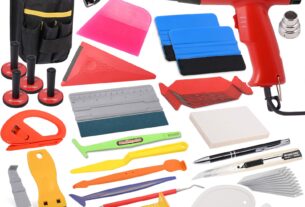If you’re looking for a reliable and efficient way to fasten metal sheets together, then a riv nut tool is the perfect solution. These tools are designed to insert rivet nuts securely into metal sheets without causing any damage or deformation. Whether you’re working on an automotive project, building furniture, or repairing machinery, a riv nut tool can make your job much easier.
In this comprehensive guide, we will cover everything you need to know about riv nut tools, including their features, benefits, types, and usage. We will also provide some tips on how to choose the best riv nut tool for your projects, as well as some safety precautions that you should keep in mind while using these tools.
So buckle up and let’s dive into the world of riv nut tools!
What is a Riv Nut Tool?
A riv nut tool is essentially a hand-held device that uses mechanical force to install blind threaded inserts (also known as rivet nuts) into metal sheets. These inserts are used to create strong and reliable threads in thin materials where traditional threading methods may not work effectively.
A typical riv nut tool consists of a mandrel (a cylindrical shaft), a nosepiece (a part that holds the insert), and handles (to apply force). The mandrel is inserted through the center of the insert and then placed into the nosepiece. When the handles are squeezed together, the mandrel pulls back while the nosepiece presses forward, thereby expanding the insert inside the metal sheet until it forms a secure thread.
Riv nut tools come in various shapes and sizes depending on their intended use. Some are designed for light-duty applications such as household repairs or hobby projects, while others are heavy-duty tools intended for industrial-grade work.
Types of Riv Nut Tools
There are two main types of riv nut tools: manual and power-operated.
Manual Riv Nut Tools
Manual riv nut tools are hand-held devices that require physical force to install the inserts. These tools are simple to use and do not require any external power source, making them ideal for small-scale projects or field repairs. Manual riv nut tools can be further classified into two categories:
1. Hand-Squeezed Riv Nut Tools: These tools work by manually squeezing the handles together to insert the rivet nut into the metal sheet. They are lightweight, portable, and easy to operate, making them a popular choice for DIY enthusiasts and hobbyists.
2. Lever-Operated Riv Nut Tools: These tools use a lever mechanism to apply force to the mandrel and insert the rivet nut into the metal sheet. They are more powerful than hand-squeezed riv nut tools and can handle larger insert sizes. However, they are also bulkier and heavier than their counterparts.
Power-Operated Riv Nut Tools
Power-operated riv nut tools use electric or pneumatic power sources to install the inserts. These tools are designed for high-volume production environments where speed and efficiency are critical factors. Power-operated riv nut tools can be further categorized into three types:
1. Electric Riv Nut Tools: These tools use an electric motor to drive the mandrel forward and insert the riv nut into the metal sheet. They are fast, precise, and easy to operate, making them ideal for automotive, aerospace, and marine applications.
2. Pneumatic Riv Nut Tools: These tools use compressed air to power the mandrel forward and install the rivet nut into the metal sheet. They are lightweight, durable, and suitable for heavy-duty industrial applications such as construction, manufacturing, and assembly.
3. Hydraulic Riv Nut Tools: These tools use hydraulic pressure to drive the mandrel forward and insert the rivet nut into the metal sheet. They offer excellent precision and control over insertion depth, making them ideal for aerospace, defense, and automotive applications.
Benefits of Using a Riv Nut Tool
Using a riv nut tool offers several benefits over traditional threading methods. Some of these benefits are:
1. Stronger Threads: Rivet nuts create stronger threads than traditional tapping methods since they distribute the load evenly along the thread length.
2. No Deformation: Rivet nuts do not deform or damage the metal sheet during installation, ensuring a clean and smooth finish.
3. Versatility: Rivet nuts can be installed in various materials such as aluminum, steel, brass, and plastic sheets, providing versatility in applications.
4. Time-Saving: Riv nut tools can install inserts quickly and efficiently, saving time and labor costs.
5. Cost-Effective: Using riv nut tools eliminates the need for expensive drilling and tapping equipment, reducing overall project costs.
Choosing the Right Riv Nut Tool
Choosing the right riv nut tool depends on several factors such as the material thickness, insert size, production volume, and application type. Here are some tips to help you choose the best riv nut tool for your projects:
1. Material Thickness: Consider the thickness of the metal sheet you will be working with when selecting a riv nut tool. Manual tools are suitable for thin materials (up to 1/4″), while power-operated tools are ideal for thicker materials (up to 1″).
2. Insert Size: Choose a tool that can handle the insert size you require for your project. Most manual tools come with interchangeable nosepieces to accommodate different insert sizes, while power-operated tools may require additional attachments or mandrels.
3. Production Volume: If you have high-volume production requirements, consider investing in power-operated tools that offer faster cycle times and higher efficiency.
4. Application Type: Different applications require different types of rivet nuts (such as open-end, closed-end, or countersunk) and corresponding tools. Make sure to choose a tool that is compatible with your application requirements.
Safety Precautions while Using a Riv Nut Tool
While using a riv nut tool, it is essential to follow some safety precautions to avoid accidents or injuries. Here are some tips to keep in mind:
1. Wear Protective Gear: Always wear protective gear such as gloves, eye goggles, and earplugs while operating the tool.
2. Check the Tool: Inspect the riv nut tool for any damage or defects before use. Do not use a damaged tool.
3. Secure the Material: Ensure that the metal sheet is securely clamped or held in place before inserting the rivet nut.
4. Follow Instructions: Follow the manufacturer’s instructions while using the tool and do not exceed its recommended capacity.
5. Dispose of Waste Safely: Dispose of any waste materials (such as metal shavings) safely according to local regulations.
Conclusion
A riv nut tool is an indispensable tool for anyone working with thin metal sheets. Whether you’re a DIY enthusiast or a professional mechanic, using a rivet nut can save time, effort, and money compared to traditional threading methods. With so many types and brands of riv nut tools available in the market, choosing the right one can be overwhelming. However, by following our guide and keeping safety precautions in mind, you can select the best riv nut tool for your projects and achieve great results!
References:
1. https://en.wikipedia.org/wiki/Rivet_nut
2. https://www.popularmechanics.com/home/tools/reviews/g259/10-must-have-tools-for-the-diyer/
3. https://www.thegrommet.com/blog/how-to-use-a-riveter-tool/
4. https://www.youtube.com/watch?v=qCvKgDl7kYQ
5. https://www.hunker.com/13401560/how-to-use-a-pop-riveter
6. https://www.doityourself.com/stry/how-to-use-a-rivnut-tool
Hyperlinks:
1. https://www.popularmechanics.com/
2. https://www.thegrommet.com/
3. https://www.youtube.com/
4. https://www.hunker.com/
5. https://www.doityourself.com/




